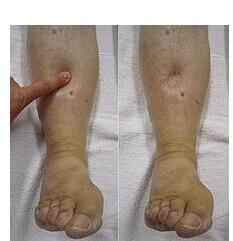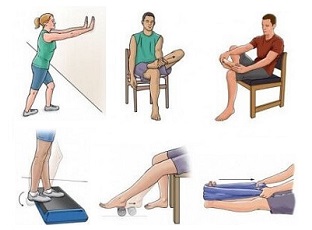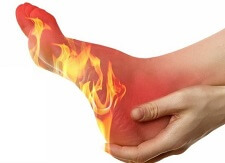- Home
- Foot Pain Symptoms
- Foot Swelling
Swollen Feet and Ankles
Written By: Chloe Wilson BSc(Hons) Physiotherapy
Reviewed By: FPE Medical Review Board
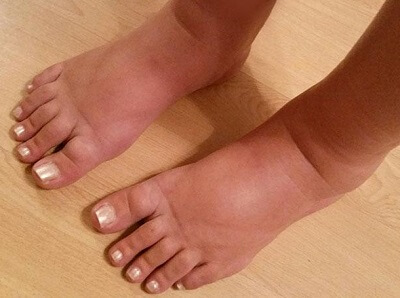
Swollen feet and ankles are a common problem that will affect most of us at some point in our lives.
Most of the time, foot swelling is not serious and will resolve quickly, but sometimes it can be a sign of a serious health problem that requires medical attention.
Here, we will look at the ten most common causes of swollen feet and ankles, the different types of swelling, how to tell if foot swelling is serious and then go on to look at the best swollen foot treatment options.
What Causes Foot & Ankle Swelling?
Swollen feet and ankles typically develop when there is a build-up of fluid in the soft tissues. The fluid seeps out of the small blood vessels and collects in the nearby tissues and as a result sodium (salt) and water levels increase.
The kidneys respond by increasing the amount of blood circulating round the body which can lead to further fluid leakage and more swelling. The lymphatic system should work to remove excess fluid, but if it is not functioning properly, fluid builds up.
Foot swelling can also occur due to bleeding usually due to an injury, inflammation, infection or lymphedema. The medical term for swollen feet and ankles is peripheral edema. If there is a specific lump on the foot rather than more generalised swelling, check out the foot lumps article.
Let's have a look at the most common causes of swollen feet and ankles.
Swelling From Foot & Ankle Injuries
Injuries to the soft tissues of the foot and lower leg can lead to swelling
which is usually fairly localized and will only affect one leg. Swollen feet and ankles may develop suddenly or gradually depending on
the nature and severity of the injury.
1. Immediate Foot Swelling
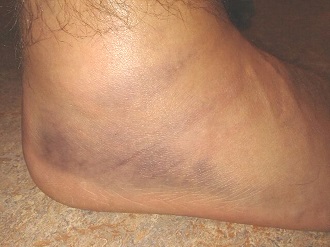
A swollen ankle or foot that develops immediately after an injury is usually caused by bleeding into the joint, known as a hemarthrosis.
The ankle and foot quickly balloons feeling tight and may be accompanied with bruising.
Typical injuries that result in rapidly swollen feet and ankles include a ligament tear or bone fracture. Foot swelling of this nature needs immediate medical attention.
2. Delayed Swelling
Foot and ankle swelling that builds up slowly, which you may not notice until a few hours or days after an injury, is caused by an increase in synovial fluid in the local area.
This occurs when there is irritation to one of the joint structures e.g. mild ligament sprain which causes the joint to produce excess synovial fluid to try and protect itself and aid healing. There tends to be less foot swelling than with a hemarthrosis and the amount may vary from day to day.
Swelling With Medical Conditions
There are a number of medical conditions with can cause swollen feet and ankles:
1. Gout Foot
With gout, high levels of uric acid cause crystals to form in joints such as the big toe. This leads to inflammation of the joint leaving the foot swollen, red, hot and very painful.
Symptoms of gout usually start to develop at night time and come on rapidly over a few hours.
Learn more about the common causes, symptoms, diagnosis & treatment options in the gout foot section.
2. Kidney Problems
One of the important functions of the kidneys is to remove excess fluid from the body and regulate electrolyte and salt levels. If the kidneys are not functioning properly, they don't eliminate salt and fluid effectively enough which leads to a build–up of pressure on the blood vessels. This causes fluid to leak out into the surrounding tissues which can lead to foot swelling.
Swollen feet and ankles is often one of the first signs of kidney problems and tends to be worst in the morning.
3. Heart Problems
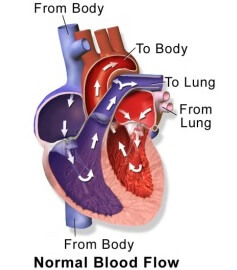
Heart problems such as congestive heart failure and hypertensive heart disease are a common cause of swollen feet and ankles.
If heart function decreases, it can’t pump the blood around the body as effectively and pressure builds up in the blood vessels causing fluid to leak into the surrounding tissues.
Gravity can then cause this fluid to pool around the feet. Swollen feet and ankles from heart disease tends to get worse during the day.
4. Arthritis
Foot and ankle swelling from arthritis tends to be sporadic, coming and going at different times. Swelling from arthritis is most commonly caused by active inflammatory synovitis (inflammation of the membrane that lines the joint) associated with rheumatoid arthritis, but you can also get swelling and hard lumps from bone spurs with osteoarthritis e.g. hallux rigidus - arthritis of the big toe
5. Liver Disease
Liver disease can cause a change in the levels of hormones and fluid-regulating chemicals leading to fluid retention and swollen feet and ankles.
6. Blood Clot/DVT
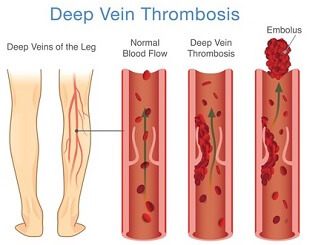
Clots can block the blood vessels preventing blood from flowing back up the leg to the heart. A blood clot that forms in one of the major vessels is known as a DVT – deep vein thrombosis.
A DVT usually causes pain and swelling in the calf as well as redness and warmth over the area. It will usually only occur in one leg at a time and the pain tends to get worse if you pull your toes up towards you.
You are more at risk of a DVT after severe injuries e.g. broken bones, prolonged inactivity e.g. long-haul flights, surgery or if you suffer from medical conditions such as heart or lung disease. A DVT is a medical emergency – if you suspect a DVT seek medical assistance immediately.
7. Pregnancy

Pregnancy is another of the common causes of swollen feet and ankles. There are three reasons for this:
- the excess weight gained puts more pressure on the legs and feet
- the expanding uterus can place pressure on the blood vessels for the legs and
- pregnancy hormones cause the body to retain fluids
Severe swelling of feet in pregnancy can be a sign of pre-eclampsia which is a medical emergency so always discuss it with your doctor or midwife.
8. Venous Insufficiency
Veins work to pump blood back up from the feet and legs to the heart through one-way valves. If these valves stop working properly due to weakness or damage, fluid can seep back down and pool causing swollen feet and ankles.
9. Cellulitis
Cellulitis can lead to swelling of the foot, ankle and calf region and is caused by a bacteria which enters the body through a break in the skin. The break can be so small sometimes, that you can’t see it. Cellulitis most common affects the skin on the lower legs or face. The area appears red, hot and swollen.
Cellulitis is treated with antibiotics and can last anything from a few days to a number of months.
10. Lymphedema
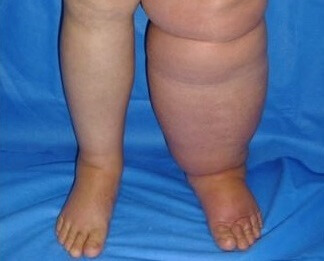
A blockage in the lymphatic system causes excess lymph fluid to collect in the tissues and can cause swollen feet and ankles.
It can be caused by a number of things such as infection, injury or cancer treatment such as radiotherapy or the removal of lymph nodes.
Lymphedema is usually treated by a combination of exercises to get the fluid to pump out of the legs and back into the circulation (known as lymphatic drainage), compression bandages such as tubigrip, and specialised lymphatic massage.
Swelling Due To Medication
Some medications can cause fluid-retention as a side effect leading to swollen feet and ankles. The most common medications causing foot swelling are:

- Anti-Inflammatories: e.g. steroids and NSAIDs
- Hormone Drugs: e.g. contraceptives
- Antidepressants: e.g. tricyclics such as amitriptyline
- Diabetes drugs: e.g. Avandia & Actos
- Blood-Pressure Medications: e.g. calcium channel blockers such as amlodipine and nifedipine
Swelling From Prolonged Inactivity
Staying in one position for long periods without moving around to pump the fluid back up into circulation can cause swollen feet and ankles. A typical example of this is travelling long distance by car or plane. Fluid naturally seeps down to your feet because of gravity.
Ideally, you want to get up and walk around every hour or so and when you are sitting, pump your feet up and down to keep the fluid moving round your body. Doing simple exercises can really help, particularly when you first wake up to help reduce morning foot pain.
Other Causes Of Foot Swelling
There are a few other causes of foot swelling:
- Obesity: obesity can cause swollen feet and ankles due to the excess weight going through the feet
- Prolonged Standing: standing or walking for long periods can lead to swollen feet and ankles
- Gender: edema is more common in women due to the hormone progesterone which causes fluid retention e.g. swollen ankles before menstruation
If only one foot is affected, it is likely due to a local problem such as an injury or a problem in one of the veins.
If the swelling is in both feet, it is probably due to a systemic problem which affects the entire body system such as heart disease.
Different Types of Swelling
There are two types of swelling, pitting edema and non-pitting edema which present differently:
Pitting Oedema
With pitting oedema, if you press on the swollen area for a few seconds and then take your finger away, an indentation will be left that lasts for a while.
A mild example of this is if you wear socks all day, when you take them off at the end of the day, there will be an indentation.
Pitting edema usually results from water retention and is associated with things such as heart failure, pregnancy and systemic diseases.
Non-Pitting Oedema
With non-pitting oedema, no indentation is left when you press on the area. The most common cause of non-pitting edema is lymphedema.
Pitting edema is the most common type of foot swelling, but if there is only a small amount of swelling, there won’t be any noticeable pitting.
If you have more of a defined lump rather than general swelling in the foot, check out the Foot Lumps article.
Treating Swollen Feet and Ankles
Treatment for swollen feet and ankles aims to improve the lymphatic drainage in the legs to reduce the swelling and associated discomfort. There are a number of ways to do this including specially designed compression bandages, massage, diet and lifestyle changes and exercises.
In the Swollen Foot and Ankle Treatment section we look at the best ways to treat the different causes of foot swelling, most of which you can do yourself at home, including:
- Dietary Changes: what to eat and drink
- Rest v Activity: how to get the right balance
- Therapeutic Massage
- Medication
- Compression Stockings
- Lifestyle Changes: e.g. footwear & clothing
Find out more about how to treat swollen feet and ankles >
When is Foot Swelling Serious?
Some causes of swollen feet are a medical emergency. If a swollen ankle or foot develops rapidly and profusely, is accompanied by pain, redness, warmth, shortness of breath or fever, lasts longer than 24 hours or is getting progressively worse, consult your doctor immediately.
It is really important to understand the underlying cause of the swelling to treat it effectively. So if none of these are sounding like your problem, visit the foot pain diagnosis section for help working out what is causing your swollen feet and ankles and what you can do to solve it.
You may also be interested in the following articles:
- Foot Lumps
- Pain On Top Of Foot
- Ball Of Foot Pain
- Foot Arch Pain
- Heel Pain
- Nerve Pain In The Foot
- Foot Numbness
- Why Are My Feet Swollen
Related Articles
References
Page Last Updated: 21st January, 2025
Next Review Due: 21st January, 2027

